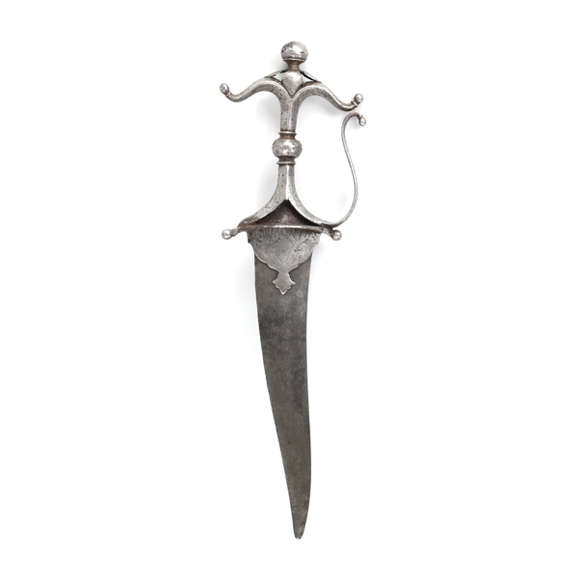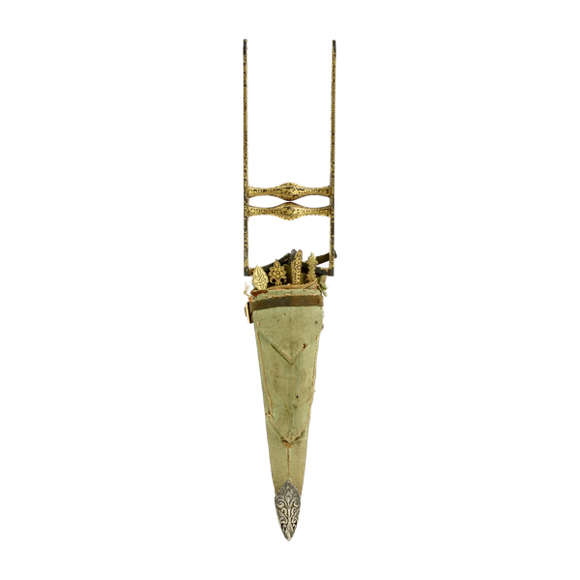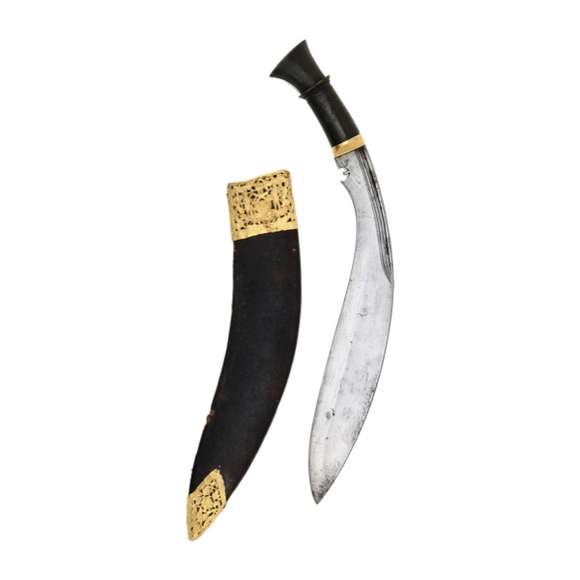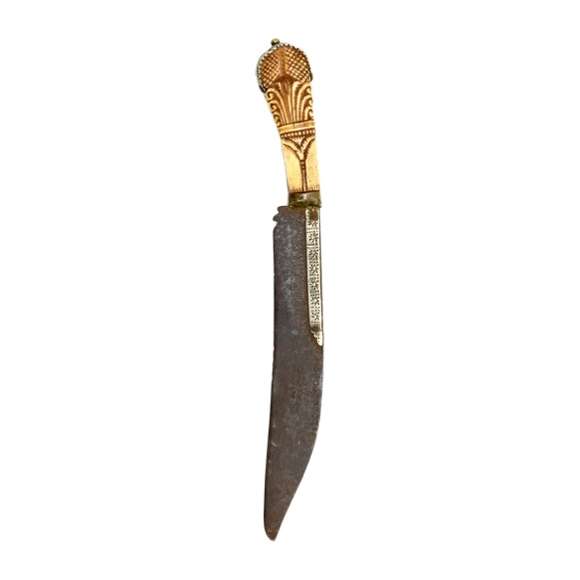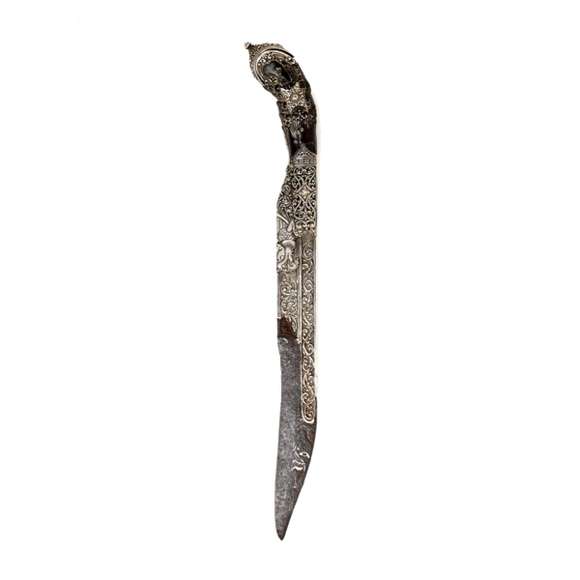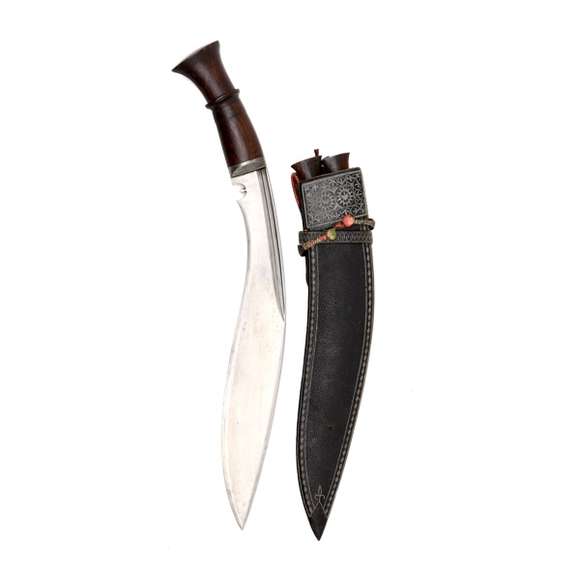Somewhat worn but once very high-quality, with great sculptural qualities and remains of silver "true…

37.5 cm
22.4 cm
Base 6 mm
Middle 4 mm
Near tip 3 mm
Base 30 mm
Middle 31 mm
Near tip 23 mm
263 grams
5 mm from hilt
Burma (Myanmar)
Iron/steel, wood, silver, elephant ivory (elephas maximus)
19th century
This dagger was sold in 2020.
Introduction
The dha hmyaung is the small version of the dha sword. Simple versions were worn by men as everyday utility knives. More ornamental ones like these were worn for personal protection and as status symbols.
This example
A large example with a blade with a gracious contour and a combination of narrow grooves and long back bevel. Unfortunately, it has lots of pitting in the center but the quality of the blade is still obvious through the precision of its geometry.
Hilt
The hilt is connected to the blade with a silver ferrule in typical Shan style with bands of twisted silver wire. The finely carved ivory hilt is, of course, the star of the show. It is worked to great detail and complexity and is one of the finest examples of such hilts I have seen so far.
According to a monograph of 1900, Burmese ivory carving saw its height between 1870 and 1900. Two rival families of carvers claimed to have invented the craft in recent times, while some legends suggest much earlier origins.
The best carving in ivory was done in Moulmein (Mawlamyine) in the southern stretch of Burma with some "fairly good work" done in Pyinmana in central Burma. There had also been a carver active in Rangoon (Yangon), but by 1900 he had retired and outsourced orders to Moulmein.
In Moulmein, the ivory is procured chiefly from Shan traders and occasionally from the local timber mills, or the Commissariat Department when an elephant happens to die or break its tusks.
Apparently, all ivory carving was done on special order:
Articles are not manufactured in anticipation of the demand, but solely to meet orders received.1

Iconography
As these hilts were all custom ordered, no two were the same. They tend to be full of symbolism that probably says something about the owner and the intended purpose of the knife. On this example, the main figure is a fierce looking demon on a horse that is about to crush two people below. The demon is a Burmese type of ogre, locally called nat. This particular one could be the fierce nat Ponnaka.2
In one story, Ponnaka was sent out by the Naga queen to get the heart of Widura-Pannita, an early incarnation of the Buddha. When Ponnaka was about to kill Widura-Pannita to take the heart, Widura-Pannita told him that the Naga queen was not after his actual heart, but his teachings. Ponnaka was eventually converted by Widura-Pannita and accepted his teachings. Widura-Pannita was introduced to the Naga queen and began teaching the entire family.
Scabbard
The scabbard is made of a dark hardwood with mounts of silver sheet worked in repousse with typical Burmese floral motifs. The mounts take influence from both Vietnamese and Chinese work.
Notes
1. 1. H.S. Pratt, I.C.S.; Monograph on Ivory Carving in Burma, Rangoon, Printed by the Superintendent, goverment Printing Burma, 1901. (Written in 1900.)
2. Robert Hales; Islamic and Oriental Arms and Armour: A Lifetime's Passion, England, 2013. Pages 148-149.
CITES
To meet the demands of the Convention International Trade of Endangered Species (CITES), this object is sold with an appraisal document from a certified Dutch appraiser of the TMV Federation. Among others, it states that the item is manufactured in the 19th century. The handle is of ivory of the species Elephas Maximus, listed on CITES appendix I.
The item is within article 2 of council regulation EC NO338/97 and within Convention of International Trade of Endangered Species (CITES): The materials were removed from the wild and significantly altered from their natural state well before the date of the convention: June 1st, 1947. It can be freely traded within the EU without a permit and is eligible for a CITES export permit for trade outside of the EU.
Buyers outside of Europe: Beware that it may not be possible to export the item to your country due to restrictions on international ivory trade. CITES sets the minimal restrictions, countries, and states under the convention often maintain further restrictions on top of CITES. I will be happy to advise.












Thought to have been presented by the Royal House of Nepal.
Of nice quality, with unusual openwork silver bolster with serapendiya.
An understated, elegant khukuri of substantial proportions with fine layered blade.

